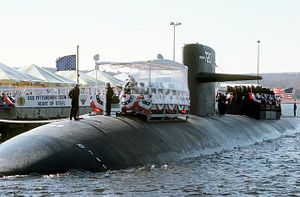USS Pittsburgh, a Los Angeles-class nuclear fast-attack submarine, returned to Naval Submarine Base New London in Groton, Connecticut, after an incident involving its on-board nuclear reactor. According to the Associated Press, the submarine suffered a “minor” moisture leak within its onboard reactor.
“The USS Pittsburgh (SSN 720) recently returned from sea to conduct logistics, maintenance, and repairs,” a statement attributed to Cmdr. Sarah Self-Kyler, a spokesperson for the U.S. Navy’s Atlantic submarine fleet, and given to The Day said last week. “This action is not uncommon, and ensures the ship is maintained at a high state of readiness.”
“The amount of moisture was so small that it was only detected by sensitive humidity detection equipment inside the ship’s reactor compartment, a typically unmanned space,” Self-Kyler said. The moisture was reportedly entirely contained within the submarine’s reactor compartment and did not present a major threat to the integrity or safety of the on-board reactor.
The incident will reportedly not affect the U.S. Navy’s ongoing operations. “USS Pittsburgh’s return to port does not create a lack of presence,” the statement attributed to Self-Kyler said. “The Submarine Force remains fully ready to support combatant commanders worldwide.”
USS Pittsburgh is among the oldest serving nuclear attack submarines in service with the U.S. Navy today. It was first commissioned in 1985 and may be decommissioned in 2019. It’s unclear if the reactor-related incident will allow the vessel to return to sea before its decommissioning.
Los Angeles-class submarines use the S6G naval reactor, designed by General Electric. The S6G has a capacity of 165 megawatts and drives two 25 megawatt steam turbines.
Crewed by 12 officers and 98 enlisted sailors, USS Pittsburgh is part of the U.S. Atlantic Fleet’s battle force. The vessel has a submerged full displacement of 6,193 tons, a length of 362 feet, and a beam measurement of 33 feet. It uses a nuclear-powered steam turbine for propulsion.
The vessel participate in strikes on Iraq in 1991 during Operation Desert Storm using submarine-launched Tomahawk cruise missiles. It returned in early 2003 to participate in strikes as part of Operation Iraqi Freedom.
Nuclear submarines like the Pittsburgh use on-board pressurized-water nuclear reactors, which are designed to circulated pressurized water through a reactor, which causes it to heat. That heat is then used to power the propulsion turbines and the on-board power turbine generators.

































